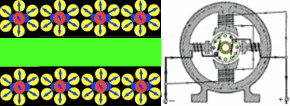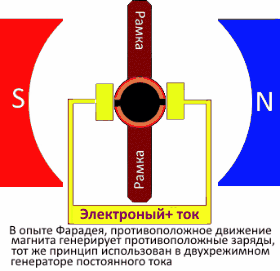
Opening: no current can flow anywhere without zero potential
Two hundred years ago, Faraday, through an inductor and a magnet moving in it, received an induction current. Moreover, with the opposite direction of motion of the magnet in the inductor, the arrow of the galvanometer reflects this opposite. And this means that the induction current is carried out by opposite charges, which is fixed by oscillograms.
And since there are no other charges inside the conductor, in addition to mobile electrons and stationary ions, the Faraday induction current is an electron-positron current propagating in the ether adjacent to the conductor.
In the modern theory of electricity, it was believed that Coulomb forces act only between charges. In fact, between the opposite charges in metal conductors there is a conductor with a zero charge. And it is this conductor with a zero charge that is the central element of electricity, without which no current will run anywhere because the difference in electric potentials between the zero charge of the conductor and the negative (or positive) charge of the current source gives rise to the force of charge movement in the circuit, gives rise to EMF.

The zero potential is like a zero springboard, from where the force of movement of opposite charges takes its development.
There is no electric current in metallic conductors flowing from plus to minus.
In a single-phase system, direct current is the movement of the positron current from the positive phase to zero or the electron current from zero to negative phase.
Waveforms demonstrates this point. Alternating current is formed in the same way, only with the observance of the sequence of flow of opposite charges specified by the generator, called alternating current frequency.
Alternating current is formed in the same way, only with the observance of the sequence of flow of opposite charges specified by the generator, called alternating current frequency.
In a three-phase system, the movement of charges is carried out according to the general law: the movement of the positron current from the plus phase to zero, the electron current from zero to the negative phase.
I
As electrons and positrons turn into each other.
In our opinion, the rectification of alternating currents occurs through the transformation of electrons and positrons into each other.
This is explained by the fact that all elements of the electron's magnetoelectric system are opposite to all elements of the positron's magnetoelectric system. And this opposite is determined by the vector of their movement in space.
Therefore, it is only necessary to change the motion vector of one of the charges to the opposite vector, so immediately this charge turns into its antipode.
The change of the charge motion vector to the opposite vector is carried out by means of diode bridges or a brush mechanism of the DC generator.
In electrical engineering, diode bridges cope immaculately with their task of changing the charge motion vector.
But the theory of this phenomenon is confused and dark. And this is natural because the generally accepted movement of current as the flow of positive charges from plus to minus, and electrons from negative to positive, does not correspond to objective reality.
To understand the operation of diode bridges, it is necessary to understand that the potential difference between the positive potential and the zero potential, as well as the potential difference between the zero potential and the negative potential, are equivalent positive potentials, which open semiconductor diodes.
And the potential difference between the negative potential and the zero potential, as well as the potential difference between the zero potential and the positive potential, are equivalent negative potentials that are opened by vacuum diodes.
The animation shows how a semiconductor bridge of a single-phase system transmits a positron current driven by a potential difference between positive and zero. But when its equivalent is supplied to the bridge, that is, the potential difference between zero and minus is applied, which opens the same diodes, this is where the motion vector of electrons is replaced by the motion vector of positrons, with the conversion of electrons into positrons.
Similarly, the transformation of positrons into electrons in a bridge assembled on vacuum diodes.
In a single-phase system, two diodes are always open, the other two are always closed.
In three-phase bridges, half of the diodes are always open, the other half are always closed.
DC generators generate a positron current with right rotation, and generate an electronic current with left rotation.
This phenomenon is explained by the fact that the charge that is formed first sets the motion vector, and the antipode is forced to follow the accepted motion vector.
The electron motion vector is opposite to the positron motion vector, both in conductors and in electromagnetic waves.
Conclusion:
1. Any curious eighth-grader is able to carry out the experiments described.
2. The comicity of the situation lies in the fact that with a wide distribution of oscilloscopes, any inquisitive eighth-grader on the screen observes that the current is movement, both negative and positive charges.
3. Two hundred years ago, Faraday received a current with negative and positive charges, which spreads in the ether layer adjacent to the conductor.
4. All modern thermal, hydraulic and nuclear power plants receive Faraday current.
5. Electrification of glass and resin sticks to obtain "glass" and "tar" electricity is the electrification of the ether layer adjacent to the sticks.
In conductors, the ether is electrified by the difference in electrical potentials, which gives rise to an electron-positron current flowing in the layer of ether adjacent to the conductor and to the conductive elements of electrical devices.
6. The flow of currents around the conductors, which is fixed by the devices, proves the existence of an all-pervading world ether.
Открытие:
без нулевого потенциала никакой ток никуда течь не может
Двести лет тому назад Фарадей, посредством катушки индуктивности и движущегося в ней магнита, получил индукционный ток. Причём, при противоположном направление движении магнита в катушке индуктивности, стрелка гальванометра отражает эту противоположность. А это означает, что индукционный ток осуществляется противоположными зарядами, что фиксируют осциллограммы.
А так как внутри проводника, кроме подвижных электронов и неподвижных ионов, других зарядов нет, то, стало быть, индукционный ток Фарадея это электронно-позитронный ток, распространяющийся в прилегающем к проводнику эфире.
Данное открытие базируется на осознание того, что в теории электричества не существует сторонней силы, вместо неё действует электродвижущая сила, формируемая разностью электрических потенциалов, между нулевым потенциалом проводника и отрицательным (или положительным) потенциалом источника тока.
В теории электричества сложилось мнение, что кулоновские силы действуют только между зарядами. На самом же деле, между разноимёнными зарядами в металлических проводниках существует нулевой потенциал проводника. И именно этот нулевой потенциал является центральным элементом электричества, без которого никакой ток никуда не побежит потому, что разность электрических потенциалов между нулевым потенциалом проводника и отрицательным (или положительным) потенциалом источника тока рождает в цепи силу движения зарядов, рождает ЭДС.
Не существует в металлических проводниках электрического тока, текущего от плюса к минусу.
В однофазной системе постоянный ток это движение позитронного тока от плюсовой фазы к нулю или электронного тока от нуля к минусовой фазе.
Осциллограммы демонстрирует эту точку зрения
Переменный ток формируется точно также, только с соблюдением заданной генератором тока очерёдности протекания разноимённых зарядов, называемой частотой переменного тока.
В трёхфазной системе движение зарядов осуществляется по общему закону: движение позитронного тока от плюсовой фазы к нулю, электронного тока от нуля к минусовой фазе.
Как электроны и позитроны превращаются друг в друга.
По нашему мнению выпрямление переменных токов происходит посредством превращения электронов и позитронов друг в друга.
Объясняется это тем, что все элементы магнитоэлектрической системы электрона противоположны всем элементам магнитоэлектрической системы позитрона. И эта противоположность определяется вектором их движения в пространстве.
Поэтому, стоит только поменять вектор движения одного из зарядов на противоположный вектор, так сразу же этот заряд превращается в своего антипода.
Смена вектора движения заряда на противоположный вектор осуществляется посредством диодных мостов или щёточного механизма генератора постоянного тока.
В электротехнике диодные мосты со своей задачей по смене вектора движения зарядов справляются безукоризненно.
Но теория этого явления путана и темна. И это естественно потому, что общепринятое движение тока как протекание положительных зарядов от плюса к минусу, а электронов от минуса к плюсу, не соответствует объективной реальности.
Чтобы уяснить работу диодных мостов, необходимо понять, что разность потенциалов между плюсовым потенциалом и нулёвым потенциалом, а также разность потенциалов между нулёвым потенциалом и минусовым потенциалом есть равноценные положительные потенциалы, которые открывают полупроводниковые диоды.
А разность потенциалов между минусовым потенциалом и нулевым потенциалом, а также разность потенциалов между нулевым потенциалом и плюсовым потенциалом есть равноценные отрицательные потенциалы, которые открывают вакуумные диоды.
Анимация показывает, как полупроводниковый мост однофазной системы пропускает позитронный ток, движимый разностью потенциалов между плюсом и нулём. Но, когда на мост подаётся его эквивалент, то есть подаётся разность потенциалов между нулём и минусом, открывающий те же самые диоды, здесь-то и происходит замена вектора движения электронов на вектор движения позитронов, с превращением электронов в позитроны.
Аналогичным образом происходит превращение позитронов в электроны в мосте, собранным на вакуумных диодах.
В однофазной системе два диода всегда открыты, два других всегда закрыты.
В трехфазных мостах половина диодов всегда открыта, другая половина всегда закрыта.
Генераторы постоянного тока генерируют позитронный ток при правом вращение, и генерируют электронный ток при левом вращении.
Объясняется это явление тем, что заряд, формирующийся первым, задаёт вектор движения, а антипод вынужден следовать принятому вектору движения.
Вектор движения электрона противоположен вектору движения позитрона, как в проводниках, так и в электромагнитных волнах.
Заключение:
1. Любой любознательный восьмиклассник способен осуществить описанные опыты.
2. Комичность ситуации заключается в том, что с широким распространением осциллографов любой любознательный восьмиклассник на экране наблюдает, что ток есть движение, как отрицательных, так и положительных зарядов.
3. Фарадей двести лет назад получил ток с отрицательными и положительными зарядами, который распространяется в прилегающем к проводнику слое эфира.
4. Все современные тепловые, гидравлические и атомные электростанции получают ток Фарадея.
5. Электризация стеклянных и смоляных палочек для получения «стеклянного» и «смолёного» электричества есть электризация прилегающего к палочкам слое эфира.
В проводниках электризация эфира осуществляется разностью электрических потенциалов, который рождает электронно-позитронный ток, текущий в слое эфира, прилегающем к проводнику и к токопроводящим элементам электрических приборов.
6. Протекание токов вокруг проводников, которое фиксируется приборами, доказывает существование всепроникающего мирового эфира.
Новые публикации: |
Популярные у читателей: |
Новинки из других стран: |
 |
Контакты редакции |
О проекте · Новости · Реклама |
 Молдавская цифровая библиотека © Все права защищены Молдавская цифровая библиотека © Все права защищены
2019-2024, LIBRARY.MD - составная часть международной библиотечной сети Либмонстр (открыть карту) Сохраняя наследие Молдовы |
 Россия
Россия
 Беларусь
Беларусь
 Украина
Украина
 Казахстан
Казахстан
 Молдова
Молдова
 Таджикистан
Таджикистан
 Эстония
Эстония
 Россия-2
Россия-2
 Беларусь-2
Беларусь-2

 США-Великобритания
США-Великобритания
 Швеция
Швеция
 Сербия
Сербия